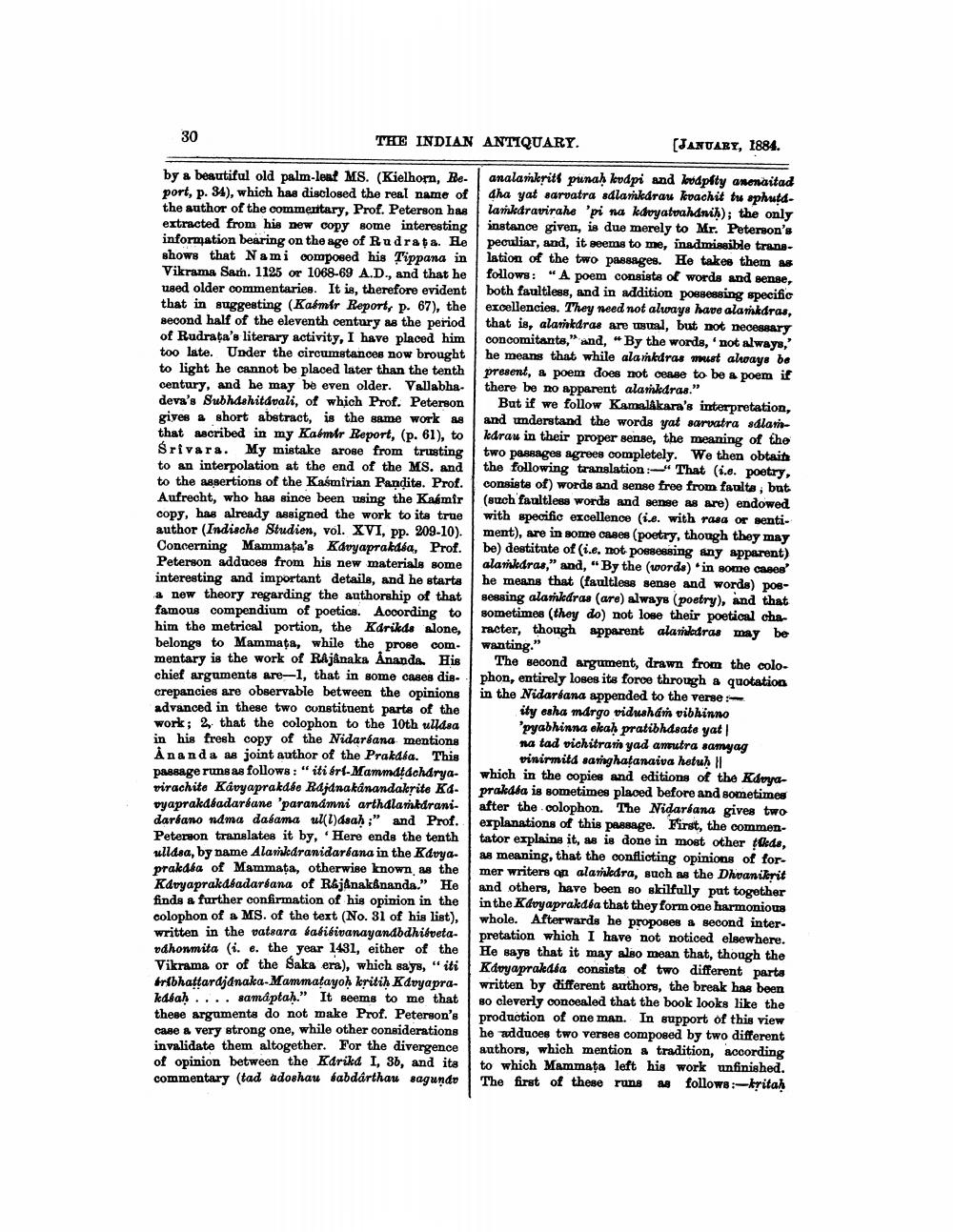________________
30
THE INDIAN ANTIQUARY.
by a beautiful old palm-leaf MS. (Kielhorn, Beport, p. 34), which has disclosed the real name of the author of the commentary, Prof. Peterson has extracted from his new copy some interesting information bearing on the age of Rudrata. He shows that Nami composed his Tippana in Vikrama Sam. 1125 or 1068-69 A.D., and that he used older commentaries. It is, therefore evident that in suggesting (Kasmir Report, p. 67), the second half of the eleventh century as the period of Rudrata's literary activity, I have placed him too late. Under the circumstances now brought to light he cannot be placed later than the tenth century, and he may be even older. Vallabhadeva's Subhashitávali, of which Prof. Peterson gives a short abstract, is the same work as that ascribed in my Kaémir Report, (p. 61), to Srivara. My mistake arose from trusting to an interpolation at the end of the MS. and to the assertions of the Kasmirian Pandits. Prof. Aufrecht, who has since been using the Kasmir copy, has already assigned the work to its true author (Indische Studien, vol. XVI, pp. 209-10). Concerning Mammata's Kavyaprakása, Prof. Peterson adduces from his new materials some interesting and important details, and he starts a new theory regarding the authorship of that famous compendium of poetics. According to him the metrical portion, the Kárikás alone, belongs to Mammata, while the prose commentary is the work of Rajânaka Ananda. His chief arguments are-1, that in some cases discrepancies are observable between the opinions advanced in these two constituent parts of the work; 2, that the colophon to the 10th ullása in his fresh copy of the Nidaréana mentions Ananda as joint author of the Prakdéa. This passage runs as follows: "iti ért-Mammaṭdcharyavirachite Kavyaprakdbe Rájánakanandakṛite Kávyaprakasadarsane 'paranámni arthalamkáranidaréano nama dasama ull)ásah ;" and Prof. Peterson translates it by, Here ends the tenth ullása, by name Alamkaranidaréana in the Kavyaprakdéa of Mammata, otherwise known as the Kavyaprakáéadaréana of Rájánakananda." He finds a further confirmation of his opinion in the colophon of a MS. of the text (No. 31 of his list), written in the vatsara sabibivanayandbdhisvetaváhonmita (i. e. the year 1431, either of the
Vikrama or of the Saka era), which says, "iti bribhattardjánaka-Mammaṭayoḥ kritih Kavyaprakábaḥ.. samâptaḥ." It seems to me that these arguments do not make Prof. Peterson's case a very strong one, while other considerations invalidate them altogether. For the divergence of opinion between the Kárika I, 36, and its commentary (tad adoshau sabdárthau sagundo
[JANUARY, 1884.
analamkriti punaḥ kvdpi and kvdpity anenaitad dha yat sarvatra sálamkárau kvachit tu sphutdlamkaravirahe 'pi na kávyatvahdnik); the only instance given, is due merely to Mr. Peterson's peculiar, and, it seems to me, inadmissible translation of the two passages. He takes them as follows: "A poem consists of words and sense, both faultless, and in addition possessing specific excellencies. They need not always have alamkáras, that is, alamkdras are usual, but not necessary concomitants," and, "By the words, 'not always,' he means that while alamkdras must always be present, a poem does not cease to be a poem if there be no apparent alamkdras."
But if we follow Kamalakara's interpretation, and understand the words yat sarvatra sálamkdrau in their proper sense, the meaning of the two passages agrees completely. We then obtain the following translation: That (i.e. poetry, consists of) words and sense free from faults; but (such faultless words and sense as are) endowed with specific excellence (ie. with rasa or sentiment), are in some cases (poetry, though they may be) destitute of (i.e. not possessing any apparent) alamkdras," and, "By the (words) in some cases' he means that (faultless sense and words) possessing alamkáras (are) always (poetry), and that sometimes (they do) not lose their poetical cha racter, though apparent alamkras may be wanting."
The second argument, drawn from the colophon, entirely loses its force through a quotation in the Nidaréana appended to the verse:
ity esha margo vidushám vibhinno 'pyabhinna ekaḥ pratibhasate yat na tad vichitram yad amutra samyag vinirmitá samghatanaiva hetuḥ || which in the copies and editions of the Kdeyaprakdéa is sometimes placed before and sometimes after the colophon. The Nidaréana gives two explanations of this passage. First, the commentator explains it, as is done in most other tkde, as meaning, that the conflicting opinions of former writers on alamkára, such as the Dhvanikrit and others, have been so skilfully put together in the Kavyaprakdéa that they form one harmonious whole. Afterwards he proposes a second interpretation which I have not noticed elsewhere. He says that it may also mean that, though the Kavyaprakdéa consists of two different parts written by different authors, the break has been so cleverly concealed that the book looks like the production of one man. In support of this view he adduces two verses composed by two different authors, which mention a tradition, according to which Mammata left his work unfinished. The first of these runs as follows:-kritaḥ




